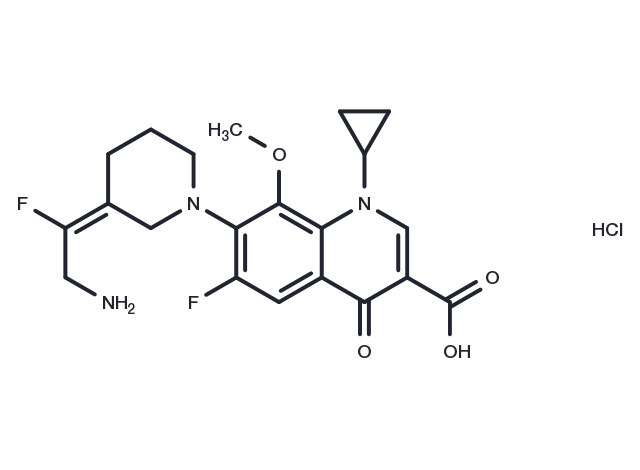Powder: -20°C for 3 years | In solvent: -80°C for 1 year


Acorafloxacin is a broad-spectrum fluoroquinolone antibacterial drug being developed for the treatment of acute bacterial skin and skin structure infections and community-acquired pneumonia.

| Pack Size | Availability | Price/USD | Quantity |
|---|---|---|---|
| 25 mg | 8-10 weeks | $ 2,120.00 | |
| 50 mg | 8-10 weeks | $ 2,780.00 | |
| 100 mg | 8-10 weeks | $ 3,700.00 |
| Description | Acorafloxacin is a broad-spectrum fluoroquinolone antibacterial drug being developed for the treatment of acute bacterial skin and skin structure infections and community-acquired pneumonia. |
| Synonyms | JNJ-32729463, JNJ-Q2 hydrochloride, Acorafloxacin hydrochloride, JNJ 32729463, JNJ-Q2 HCl |
| Molecular Weight | 455.88 |
| Formula | C21H24ClF2N3O4 |
| CAS No. | 1001162-01-1 |
Powder: -20°C for 3 years | In solvent: -80°C for 1 year
You can also refer to dose conversion for different animals. More
bottom
Please see Inhibitor Handling Instructions for more frequently ask questions. Topics include: how to prepare stock solutions, how to store products, and cautions on cell-based assays & animal experiments, etc.
Acorafloxacin HCl 1001162-01-1 Acorafloxacin Hydrochloride JNJ-32729463 JNJ-Q2 hydrochloride Acorafloxacin hydrochloride JNJ 32729463 JNJ-Q2 Hydrochloride JNJ-Q2 HCl JNJ32729463 inhibitor inhibit
